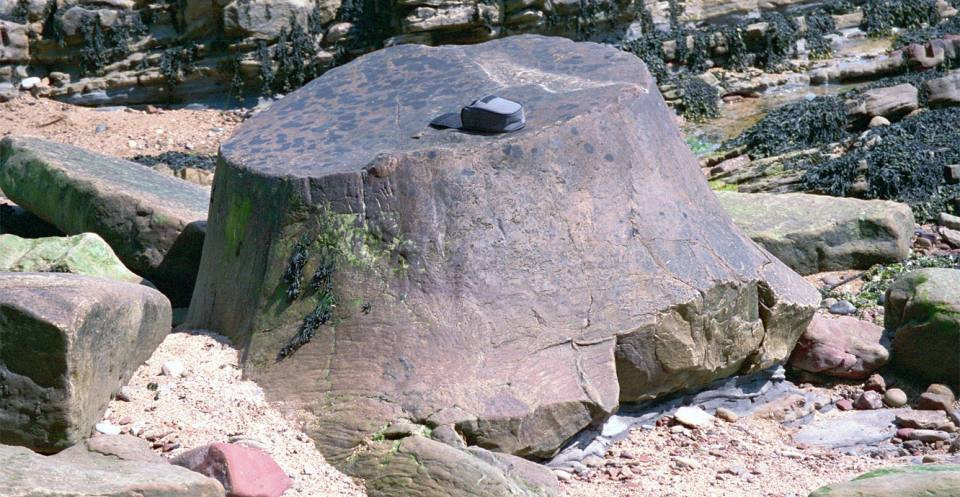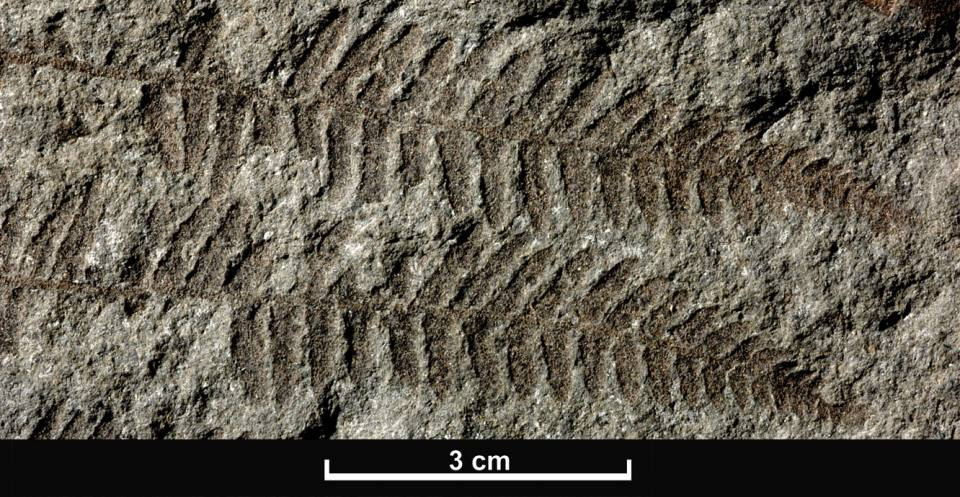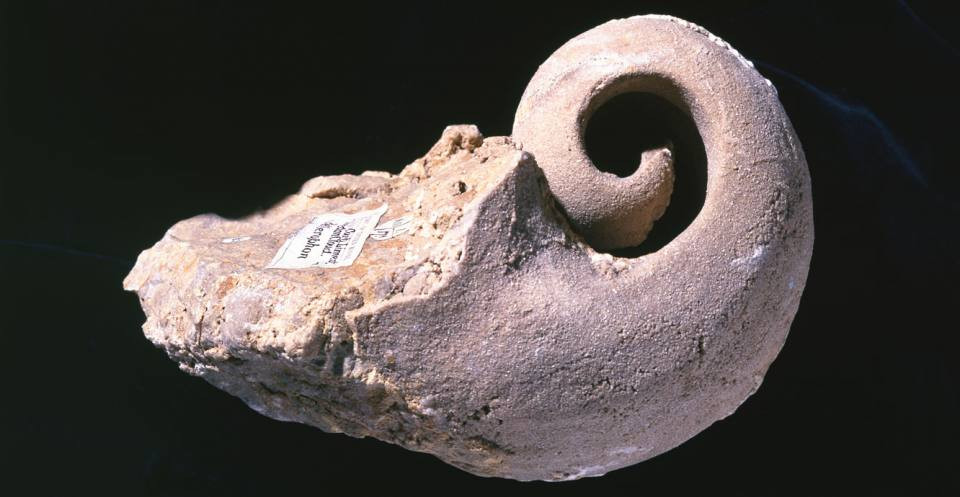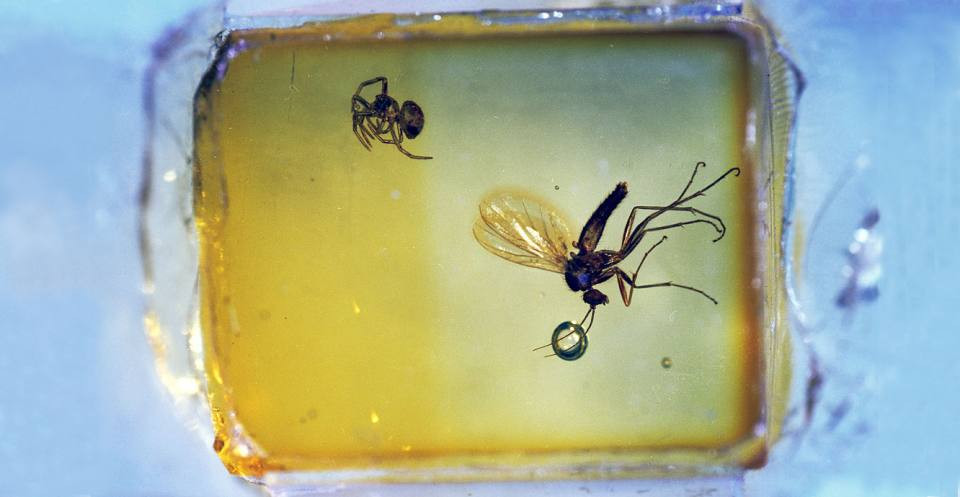How Are Fossils Formed In Sedimentary Rocks? Fossils are created through a fascinating process where the remains of ancient life are preserved within sedimentary rocks, a key element of your rock garden and landscape design, and Rockscapes.net is here to guide you. Discover how petrification, compression, molds, and preserved remains contribute to this amazing transformation, enriching your understanding and appreciation of the natural world.
1. What is a Fossil and Why Does It Matter?
A fossil is the preserved remains or traces of ancient life forms, typically over 10,000 years old, found in sedimentary rocks, offering vital insights into Earth’s history and the evolution of life and helps to enhance the beauty of your rockscapes and landscape designs. These remnants can include bones, shells, teeth, or even traces like footprints and burrows.
1.1 Understanding Fossils
Fossils are more than just old bones; they are time capsules that provide invaluable data about past environments, climates, and the evolution of organisms. According to research from the Paleontological Society, fossils allow scientists to piece together the history of life on Earth, revealing how different species adapted and changed over millions of years.
1.2 Types of Fossils
There are two primary types of fossils:
- Body Fossils: These are the preserved remains of an organism’s body parts, such as bones, shells, and teeth.
- Trace Fossils: These are the preserved evidence of an organism’s activity, such as footprints, burrows, and even fossilized dung (coprolites).
1.3 The Significance of Fossils
Fossils are significant for several reasons:
- Evolutionary Evidence: They provide direct evidence of how life has evolved over time.
- Dating Rocks: Certain fossils, known as index fossils, can be used to determine the age of the rock layers in which they are found.
- Environmental Reconstruction: Fossils can help scientists understand what past environments were like, including climate, geography, and ecosystems.
- Economic Importance: Fossils can be used to locate valuable resources, such as oil and natural gas.
1.4 Where Can You Find Fossils?
Fossils are typically found in sedimentary rocks, which are formed from accumulated sediments like sand, mud, and organic matter. The best places to find fossils include:
- Riverbanks and Coastal Cliffs: Erosion often exposes fossil-bearing layers.
- Quarries and Mines: These sites provide access to deep rock layers.
- Deserts and Badlands: Arid environments can preserve fossils exceptionally well.
2. What are Sedimentary Rocks and Their Role in Fossil Formation?
Sedimentary rocks are types of rock that are formed by the accumulation or deposition of mineral or organic particles at Earth’s surface, followed by cementation and are the primary medium for fossil preservation, crucial for understanding Earth’s history and creating stunning rockscapes in your backyard with rockscapes.net. These rocks are essential for preserving fossils because of their formation process and composition.
2.1 Formation of Sedimentary Rocks
Sedimentary rocks are formed through a series of processes:
- Weathering and Erosion: Rocks on the Earth’s surface are broken down into smaller particles by weathering (physical and chemical breakdown) and erosion (transportation of particles).
- Transportation: The eroded particles are transported by wind, water, or ice to a new location.
- Deposition: The particles settle and accumulate in layers.
- Compaction: The weight of overlying sediments compresses the lower layers.
- Cementation: Minerals dissolved in water precipitate out and bind the sediment particles together, forming solid rock.
2.2 Types of Sedimentary Rocks
There are three main types of sedimentary rocks:
- Clastic Sedimentary Rocks: Formed from fragments of other rocks and minerals. Examples include sandstone, shale, and conglomerate.
- Chemical Sedimentary Rocks: Formed from minerals that precipitate out of water. Examples include limestone, rock salt, and chert.
- Organic Sedimentary Rocks: Formed from the accumulation of organic matter, such as plant and animal remains. Examples include coal and some types of limestone.
2.3 Why Sedimentary Rocks are Ideal for Fossil Formation?
Sedimentary rocks provide an ideal environment for fossil formation due to several factors:
- Layered Structure: The layered structure of sedimentary rocks allows for the sequential burial and preservation of organisms over time.
- Porosity and Permeability: The porous nature of many sedimentary rocks allows mineral-rich fluids to percolate through, facilitating the process of permineralization (explained below).
- Fine-Grained Texture: Fine-grained sediments, such as mud and silt, can preserve delicate details of organisms.
- Relatively Low Heat and Pressure: Unlike igneous and metamorphic rocks, sedimentary rocks form under relatively low heat and pressure, which minimizes the destruction of organic material.
2.4. Application of Sedimentary Rocks in Landscaping
Sedimentary rocks, such as sandstone, limestone, and shale, are commonly used in landscaping due to their unique textures, colors, and durability. They can be used for:
- Pathways: Creating natural-looking walkways and garden paths.
- Walls: Building retaining walls and decorative garden walls.
- Patios: Designing attractive and durable outdoor living spaces.
- Water Features: Constructing ponds, waterfalls, and fountains.
- Rock Gardens: Adding visual interest and providing habitats for plants.
3. What are the Five Crucial Steps in Fossil Formation within Sedimentary Rocks?
Fossil formation in sedimentary rocks is a complex process involving several key steps and it’s a slow process that may takes thousands or millions of years, but, it is a story that’s written in stone. Here are the five crucial steps:
- Death and Burial
- Prevention of Decay
- Permineralization
- Compaction and Lithification
- Exposure and Discovery
3.1 Death and Burial
The process begins when an organism dies. For fossilization to occur, the organism must be buried quickly in sediment. This rapid burial protects the remains from scavengers, decomposition, and weathering. Common burial environments include:
- Riverbeds: Where sediment is constantly being deposited.
- Lakebeds: Where fine-grained sediments accumulate.
- Seabeds: Where marine organisms are buried by layers of sediment.
- Volcanic Ash: Which can quickly cover and preserve organisms.
3.2 Prevention of Decay
Once buried, the remains need to be protected from decay. Several factors can help prevent decomposition:
- Lack of Oxygen: Anaerobic conditions (low oxygen) slow down the decay process.
- Acidity: Acidic environments can inhibit bacterial growth.
- Rapid Sedimentation: Quick burial ensures that the remains are isolated from destructive biological and physical processes.
- Presence of Preservatives: Substances like amber, tar, or ice can preserve organisms in their original state.
3.3 Permineralization
Permineralization is the most common method of fossilization. It occurs when mineral-rich fluids seep into the porous spaces of the buried remains. These fluids deposit minerals, such as:
- Calcium Carbonate (Calcite)
- Silica (Quartz)
- Iron Oxide (Hematite)
Over time, the minerals fill the spaces and may eventually replace the original organic material, turning the remains into stone. The result is a petrified fossil, where the original structure is preserved in mineral form.
3.4 Compaction and Lithification
As more sediment accumulates above the buried remains, the increasing pressure compacts the sediment layers. This compaction reduces the space between sediment particles, squeezing out water and air. Simultaneously, lithification occurs, where the sediments are cemented together by minerals that precipitate out of solution. The combination of compaction and lithification transforms the sediment into solid sedimentary rock, encasing the fossil within it.
3.5 Exposure and Discovery
The final step in the process is the exposure of the fossil-bearing rock at the Earth’s surface. This can occur through:
- Erosion: Wind and water gradually wear away the overlying rock layers.
- Tectonic Uplift: Geological forces raise the rock layers, exposing them to erosion.
- Human Activities: Quarrying, mining, and construction can uncover fossils.
Once exposed, the fossils can be discovered by paleontologists, geologists, or even amateur fossil hunters. The discovery of fossils provides valuable insights into the history of life on Earth, revealing the diversity and evolution of organisms over millions of years.
4. What are the Four Primary Methods of Fossil Preservation in Sedimentary Rocks?
The four primary methods of fossil preservation are petrification, compression, molds and casts, and preserved remains. Let’s explore how each of these methods contributes to the preservation of ancient life forms.
- Petrification (Permineralization)
- Compression
- Molds and Casts
- Preserved Remains
4.1 Petrification (Permineralization)
Petrification, also known as permineralization, is the most common method of fossilization. It involves the infiltration of mineral-rich fluids into the porous spaces of buried remains.
- Process: After burial, the organic material is gradually replaced by minerals such as calcium carbonate, silica, or iron compounds. These minerals fill the voids within the bone, shell, or wood, and eventually, the entire structure can be replaced by stone.
- Examples: Petrified wood is a classic example of this process, where the cellular structure of the wood is perfectly preserved in stone. Dinosaur bones are also often petrified.
- Significance: Petrification allows for the preservation of fine details, such as cell structures and growth rings.
 Petrified tree stump found in East Fife, Scotland showing permineralization.
Petrified tree stump found in East Fife, Scotland showing permineralization.
4.2 Compression
Compression occurs when the remains of an organism are subjected to high pressure from overlying sediments.
- Process: The pressure flattens the organism, leaving behind a dark imprint on the rock. This is common with plant fossils, where the leaves and stems are compressed into thin carbon films.
- Examples: Fossil ferns and leaves are often preserved through compression, showing intricate details of the plant’s structure.
- Significance: Compression fossils provide valuable information about the shape and form of organisms, although they lack the three-dimensional detail of petrified fossils.
 Plant leaves and ferns like the Coniopteris from the Jurassic Period are fossils produced by compression.
Plant leaves and ferns like the Coniopteris from the Jurassic Period are fossils produced by compression.
4.3 Molds and Casts
Molds and casts are formed when the original remains dissolve away, leaving behind an impression in the surrounding sediment.
- Process: A mold is a hollow space that reflects the shape of the original organism. If the mold is later filled with sediment or minerals, it forms a cast, which is a three-dimensional replica of the original organism.
- Examples: Shells are often preserved as molds and casts, especially in marine environments.
- Significance: Molds and casts provide external information about the shape and size of ancient organisms.
 Mold of Bellerophon, a gastropod, created when water-borne minerals percolated through the shell.
Mold of Bellerophon, a gastropod, created when water-borne minerals percolated through the shell.
4.4 Preserved Remains
Preserved remains are the rarest form of fossilization, where the original material of the organism is preserved intact.
- Process: This can occur in environments where decomposition is prevented, such as in amber, tar pits, or frozen ground.
- Examples: Insects trapped in amber, mammoths frozen in permafrost, and organisms preserved in tar pits are all examples of preserved remains.
- Significance: Preserved remains provide the most complete information about ancient organisms, including their soft tissues, DNA, and internal organs.
 Fly and spider trapped in amber.
Fly and spider trapped in amber.
5. What Environmental Factors Influence Fossil Formation?
Environmental factors play a crucial role in fossil formation, influencing the likelihood and quality of preservation. These factors include the rate of burial, sediment type, oxygen levels, acidity, and the presence of hard parts.
5.1 Rate of Burial
The rate at which an organism is buried is one of the most critical factors in fossilization. Rapid burial protects the remains from scavengers, decomposition, and weathering. Environments with high sedimentation rates, such as river deltas, floodplains, and marine basins, are more likely to produce fossils.
5.2 Sediment Type
The type of sediment in which an organism is buried also affects fossil formation. Fine-grained sediments, such as mud and silt, can preserve delicate details of organisms, while coarse-grained sediments, such as sand and gravel, may damage or destroy the remains. Additionally, the mineral composition of the sediment can influence the type of fossilization that occurs. For example, sediments rich in silica or calcium carbonate are more likely to produce petrified fossils.
5.3 Oxygen Levels
Oxygen levels in the burial environment play a significant role in decomposition. Anaerobic conditions (low oxygen) slow down the decay process, increasing the chances of fossilization. Environments with stagnant water or organic-rich sediments are often anaerobic.
5.4 Acidity
The acidity of the burial environment can also affect fossil formation. Acidic conditions can inhibit bacterial growth, which slows down decomposition. However, highly acidic environments can also dissolve bone and shell, preventing fossilization.
5.5 Presence of Hard Parts
Organisms with hard parts, such as bones, shells, and teeth, are more likely to be fossilized than organisms with only soft tissues. Hard parts are more resistant to decay and can withstand the pressures of burial and lithification.
6. How Do Paleontologists Study Fossils Found in Sedimentary Rocks?
Paleontologists study fossils using a variety of techniques to understand ancient life.
6.1 Excavation
Paleontologists carefully excavate fossils from sedimentary rock formations, documenting the precise location and orientation of each specimen. They use tools such as:
- Geological Hammers
- Chisels
- Brushes
- Shovels
6.2 Preparation
Once a fossil is excavated, it must be carefully prepared to remove excess rock and reveal its features. Preparation techniques include:
- Mechanical Preparation: Using small tools to chip away at the surrounding rock.
- Chemical Preparation: Dissolving the rock with acids.
- Air Abrasives: Using compressed air to blast away fine particles of rock.
6.3 Identification and Classification
Paleontologists identify and classify fossils by comparing them to known species and using taxonomic keys. They consider factors such as:
- Morphology (Shape and Structure)
- Anatomy (Internal Structure)
- Phylogeny (Evolutionary Relationships)
6.4 Dating
Dating techniques help paleontologists determine the age of fossils and the rock layers in which they are found. Common dating methods include:
- Relative Dating: Comparing the position of rock layers to determine relative ages.
- Radiometric Dating: Measuring the decay of radioactive isotopes to determine absolute ages.
6.5 Microscopic Analysis
Microscopic analysis can reveal fine details of fossil structure and composition. Techniques include:
- Light Microscopy
- Scanning Electron Microscopy (SEM)
- Transmission Electron Microscopy (TEM)
6.6 Imaging Techniques
Advanced imaging techniques can create detailed three-dimensional models of fossils. Methods include:
- Computed Tomography (CT Scanning)
- Magnetic Resonance Imaging (MRI)
6.7 Geochemical Analysis
Geochemical analysis can provide information about the environment in which the fossil formed. Techniques include:
- Isotope Analysis
- Trace Element Analysis
6.8 Comparative Anatomy
By comparing fossils to living organisms, paleontologists can infer how ancient creatures lived, moved, and behaved.
7. Can Fossils Tell Us About Past Environments?
Yes, fossils provide invaluable insights into past environments, allowing scientists to reconstruct ancient ecosystems, climates, and geographic conditions.
7.1 Climate Indicators
Fossils can indicate past climates. For example:
- Fossil Plants: The presence of certain plant species can indicate temperature and rainfall patterns.
- Fossil Corals: Coral reefs indicate warm, shallow marine environments.
- Fossil Pollen: Pollen grains can reveal the types of vegetation that grew in an area.
7.2 Geographic Indicators
Fossils can also reveal past geographic conditions:
- Marine Fossils: Found in inland areas indicate that the area was once covered by ocean.
- Fossil Distribution: The distribution of fossils across continents can provide evidence for plate tectonics and continental drift.
7.3 Ecosystem Reconstruction
By studying the types of fossils found together in a particular location, paleontologists can reconstruct ancient ecosystems. This includes:
- Food Webs: Determining which organisms ate which organisms.
- Habitat Preferences: Understanding where different species lived.
- Community Structure: Identifying the relationships between different species.
7.4 Sea Level Changes
Fossils can also provide evidence for past sea level changes. The presence of marine fossils in coastal areas can indicate that the sea level was once higher.
7.5 Pollution and Environmental Change
Fossils can even provide information about past pollution and environmental change. For example, the study of fossil shells can reveal changes in water chemistry over time.
8. Are There Famous Fossil Sites in the USA?
Yes, the United States is home to many famous fossil sites that have yielded important discoveries about the history of life on Earth. Here are a few notable examples:
8.1 Agate Fossil Beds National Monument, Nebraska
Agate Fossil Beds National Monument in Nebraska is famous for its well-preserved mammal fossils from the Miocene epoch (about 20 million years ago). The fossils include:
- Menoceras: A small, two-horned rhinoceros.
- Moropus: A horse-like creature with claws.
- Daeodon: A giant entelodont (“hell pig”).
8.2 Dinosaur National Monument, Utah and Colorado
Dinosaur National Monument spans the border between Utah and Colorado and is renowned for its rich deposits of dinosaur fossils from the Late Jurassic period (about 150 million years ago). The monument features:
- Allosaurus
- Stegosaurus
- Apatosaurus
- Camarasaurus
8.3 La Brea Tar Pits, California
The La Brea Tar Pits in Los Angeles, California, are famous for their Pleistocene-era fossils (about 11,000 to 50,000 years ago) preserved in asphalt deposits. The tar pits have yielded fossils of:
- Saber-Toothed Cats (Smilodon)
- Dire Wolves (Canis dirus)
- Mammoths (Mammuthus)
- Ground Sloths (various species)
8.4 Florissant Fossil Beds National Monument, Colorado
Florissant Fossil Beds National Monument in Colorado contains remarkable fossils of plants and insects from the Eocene epoch (about 34 million years ago). The fossils are preserved in fine-grained volcanic ash and include:
- Fossil Leaves
- Fossil Insects
- Fossil Fish
- Fossil Birds
8.5 Green River Formation, Wyoming, Colorado, and Utah
The Green River Formation spans parts of Wyoming, Colorado, and Utah and is famous for its exceptionally well-preserved fish fossils from the Eocene epoch (about 50 million years ago). The formation also contains fossils of:
- Fossil Insects
- Fossil Plants
- Fossil Birds
- Fossil Reptiles
8.6 Petrified Forest National Park, Arizona
Petrified Forest National Park in Arizona is famous for its large deposits of petrified wood from the Late Triassic period (about 225 million years ago). The park contains:
- Petrified Logs
- Fossil Reptiles
- Fossil Amphibians
- Fossil Plants
These are just a few examples of the many famous fossil sites in the United States. Each site offers unique insights into the history of life on Earth and provides valuable opportunities for scientific research and education.
9. What Role Do Fossils Play in Understanding Evolution?
Fossils play a crucial role in understanding evolution by providing direct evidence of how life has changed over time.
9.1 Direct Evidence of Ancestry
Fossils can reveal the evolutionary relationships between different groups of organisms. By studying the anatomical features of fossils, paleontologists can identify transitional forms that bridge the gap between ancestral and descendant species.
9.2 Dating Evolutionary Events
Fossils can be used to date evolutionary events. By determining the age of fossils, scientists can establish a timeline for when different species appeared and when major evolutionary transitions occurred.
9.3 Documenting Extinction Events
The fossil record provides evidence of past extinction events. By studying the disappearance of species from the fossil record, scientists can understand the causes and consequences of extinction.
9.4 Showing Adaptation to Environments
Fossils can reveal how organisms adapted to different environments. By studying the anatomical and physiological features of fossils, scientists can infer how ancient creatures lived and survived in their respective habitats.
9.5 Verifying Evolutionary Theory
The fossil record provides strong evidence in support of evolutionary theory. The patterns of change observed in the fossil record are consistent with the predictions of evolutionary theory, such as natural selection and genetic drift.
10. What Are Some Common Misconceptions About Fossils?
There are several common misconceptions about fossils that are important to clarify for a better understanding of paleontology.
10.1 All Fossils Are Bones
Many people assume that all fossils are bones, but fossils can be any preserved remains or traces of ancient life. Fossils can include:
- Shells
- Teeth
- Plant Leaves
- Footprints
- Burrows
- Fossilized Dung (Coprolites)
10.2 Fossils Are Only Found in Deserts
While deserts can be good places to find fossils due to the lack of vegetation and erosion exposing rock layers, fossils are found in a variety of environments, including:
- Riverbeds
- Lakebeds
- Seabeds
- Forests
- Mountains
10.3 Fossils Are Always Large and Complete
Many people imagine fossils as large, complete skeletons, but in reality, most fossils are small and fragmentary. Complete skeletons are rare finds.
10.4 Fossilization Is Common
Fossilization is actually a rare process. Most organisms decompose quickly after death, and the conditions necessary for fossilization are not always present.
10.5 Fossils Are Useless
Some people believe that fossils are just old bones with no practical value, but fossils are incredibly valuable for:
- Understanding the History of Life
- Dating Rocks
- Reconstructing Past Environments
- Providing Evidence for Evolution
- Locating Valuable Resources (e.g., Oil and Natural Gas)
Fossils formed in sedimentary rocks are a testament to the Earth’s dynamic history and the evolution of life, which aligns seamlessly with the art of crafting beautiful rockscapes. As you explore the possibilities of incorporating natural stone into your landscape, remember that each rock has its own story to tell.
Ready to bring the timeless beauty of sedimentary rocks and fossils into your landscape? Visit rockscapes.net today for inspiration, information, and expert advice on creating stunning rock gardens, pathways, and water features with sedimentary rocks. Discover the perfect stones to enhance your outdoor space and connect with the Earth’s ancient past.
You can also visit us at 1151 S Forest Ave, Tempe, AZ 85281, United States or call us at +1 (480) 965-9011.